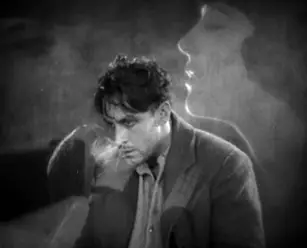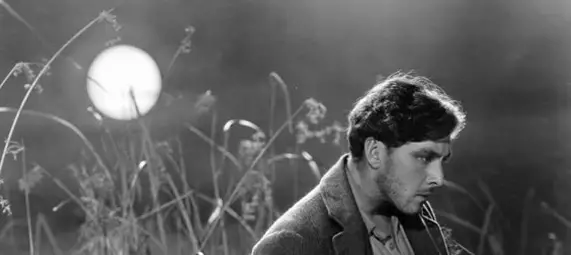
Director: F.W. Murnau
Producer: William Fox (20th Century Fox)
Writers: Hermann Sudermann (novella), Carl Mayer (scenario), Katherine Hilliker and H.H. Caldwell (titles)
Photography: Charles Rosher, Karl Struss
Music: Timothy Brock, Hugo Rosenfeld
Cast: George O’Brien, Janet Gaynor, Margaret Livingston, Bodil Rosing, J. Farrell MacDonald, Ralph Sipperly, Jane Winton, Arthur Housman, Eddie Boland, Barry Norton
![]()
Question: What was the first film to win the Academy Award for Best Picture? Answer: It’s a trick question. During the first year of the Academy Awards (1927-1928), there were actually two Best Pictures. The first, called Best Production, went to William Wellman’s war romance Wings (1927), the film most often credited as the first Oscar-winner. But the second Best Picture category, Most Unique and Artistic Production, went to F.W. Murnau’s Sunrise: A Song of Two Humans in a title as poetic as the cinematic work itself. It was the first and only time such an award was given, so it’s only fitting that it went to Murnau’s “unique and artistic” masterpiece. It remains one of the finest love stories ever told, a watershed moment in direction and visual effects, and the very pinnacle of the silent era, arriving just weeks before The Jazz Singer (1927) ushered in talking pictures.
Based on a novella by German playwright Hermann Sudermann, Sunrise was adapted into a screenplay (or “photo-play” as it was called then) by Australian writer Carl Mayer, who had just finished work on Murnau’s The Last Laugh (1924). It would tell the story of two lovers, the handsome Anses (George O’Brien) and his wholesome blonde wife Indre (Janet Gaynor). Their countryside relationship soon becomes strained by the arrival of a dark-haired temptress from the city (Margaret Livingston), who begins a lakeside affair with Anses and suggests he drown his wife so they can run off together to the city.
The story is divided into three acts. The first is a dark, suspenseful opening covering the scintillating affair and drowning plot. The second is a light series of cheerful vignettes in the city. And the third is a haunting finale as a storm unleashes chaos on the characters, which by now have our full emotions invested. The transition from each act is super smooth, forming a beautifully-woven melodrama that’s a testament to its visionary director.
A German filmmaker on par with such greats as Fritz Lang, who released the sci-fi classic Metropolis the same year, Murnau made his American debut with a style born out of German Expressionism (1914-1924), a movement in which he had made such masterpieces as the The Last Laugh (1924) and the Dracula classic Nosferatu: A Symphony of Terror (1922). Moving from this “symphony of terror” to “a song of two humans,” Murnau proves his keen eye for both romance and romanticized atmosphere, using a combination of Oscar-nominated Art Direction and forced perspectives.
Using concepts of optical illusion still relevant in such films as The Lord of the Rings and Harry Potter, Murnau pioneered ideas of visual and spacial storytelling, enlisting sets that were built decreasingly in size as if to appear fading off into the distance. In addition to these crafty experiments in depth, Murnau also enlists groundbreaking shot compositions and fluid camera movements. Note the tracking shot of Anses walking through a field before panning away from him and moving through the field brush; the complex tracking shot of Asnes and Indre crossing a busy city street, cars racing by and just missing the camera; or an elaborate single-takes entering an amusement park. Murnau was finding new ways to smoothly move his camera through the space he had created, and he knew he was onto something good.
“I think films of the future will use more and more of these camera angles, or, as I prefer to call them, these dramatic angles,” Murnau said in 1928. “They help photograph thought.” (A)
Much more revered than even these “dramatic angles” are Murnau’s groundbreaking experiments in superimposition, that is the overlapping over multiple screen images to form one multi-layered image. Note the shot of Anses and his city temptress lying in the grass, looking off into a countryside that dissolves into a city street and a montage of superimposed city images. Note also the shot of Anses sitting on his bed as images of the city girl appear around him, trying to kiss him and ultimately enveloping him in illusory seduction. Behold the ring of cupid figures appearing above Anses and Indre as they kiss. Most famously, study their second walk across traffic, which comes as both superimposed images crossing in front of them and the rear projection of images behind them, the latter of which momentarily dissolves into a green pasture as they kiss — influencing the transformative kiss of Vertigo (1958) — only to dissolve back to the traffic scene and the sound of horns honking at them.

These car horns are just one reminder that Sunrise, like many of the late silent pictures, was not completely silent. The film actually uses several added sound effects, including church bells, horse grunts, lake buoys and crowd noises, becoming the first feature film to use the Fox Movietone system of syncing. (B) In addition, the film would feature an orchestral rendition of Hugo Riesenfeld’s score, a collection of pulsating suspense, sobbing strings and moving romance, expressing as much of the story as the film’s title cards, which Murnau even plays around with, distorting and waving some of the text on top of the cards.
But Sunrise would still be a masterwork even without the cards, music or sound effects, thanks to the Oscar-winning cinematography from Charles Rosher and Karl Struss. Both were the first cinematographers to use panchromatic stock, while pioneering the use of multiple exposures, paving the way for films like Citizen Kane (1941).

Complementing these stunning images are the film’s secret weapon: two brilliant performances by the two lead actors. George O’Brien was the father of award-winning novelist Darcy O’Brien, but may be more noted as the first leading man to cry on film. The tearjerker moment comes as his character watches a wedding unfold. Remembering back on the vows he took for his own wife, he breaks down in love, humility and ultimately hope. As for his co-star, Janet Gaynor’s performance won the first ever Academy Award for Best Actress, beginning a long string of powerful leading ladies. Gaynor could never have known the importance of such an honor.
“Had I known then what it would come to mean … I’m sure I’d have been overwhelmed,” Gaynor said. :At the time, I think I was more thrilled over meeting Douglas Fairbanks (at the Oscars).” (C)
Gaynor’s experience is actually quite similar to the overall cultural embrace of Sunrise the film. Overshadowed by The Jazz Singer‘s breakthrough introduction of sound technology, Sunrise was somewhat forgotten, deemed a box office flop for not bringing a return on what had been Fox’s most expensive project up to that point. The fact that Murnau was tragically killed in a car crash less than four years later didn’t help the film’s exposure.
But over the years, academics and critics have come to realize that Sunrise was just as transformative as The Jazz Singer, pioneering ideas of space, illusion and superimposition that continue to be used today. Nearly 90 years later, Sunrise is a mainstay on most every critical best list, finally making the AFI’s Top 100 in 2007, and ranking as high as No. 5 on Sight & Sound‘s international critics poll in 2013, behind only Vertigo (#1), Citizen Kane (#2), Tokyo Story (#3) and The Rules of the Game (#4). There will always be viewers who stubbornly say, “That’s a silent movie. I have no desire to watch it.” But they’re missing out. Sunrise is without a doubt one of the finest love stories ever done.
![]()
Citations:
CITE A: IMDB Trivia
CITE B: Tim Dirks, AMC Filmsite
CITE C: 20th Century Fox Studio Classics, DVD booklet
